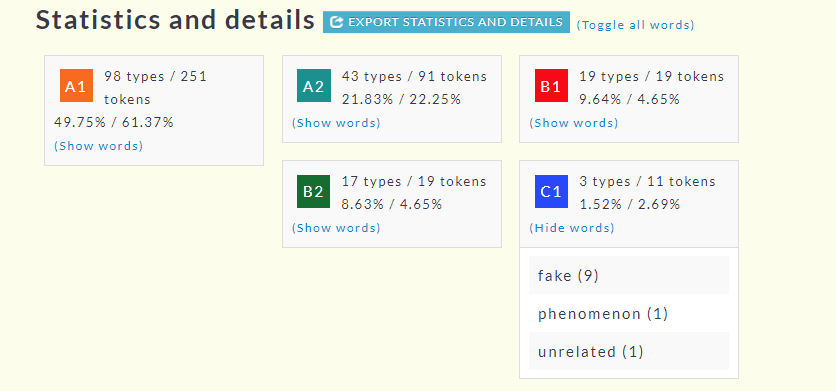
Finding the best language learning materials for your EFL class can be a challenging task, especially if you’re a new teacher.
If you’re working for a language course provider or employed by the Ministry of Education in a certain country, you may be provided with EFL materials. Or you may find that you’re responsible for creating effective course content for your students.
Although this may feel daunting, it’s an excellent opportunity to provide your English language students with language learning materials that best suit their needs.
You can make your lesson content as interesting and engaging as you want. You can design your curriculum according to the unique needs of your students and you can include as much exciting native language content as you wish.
To give you a helping hand, we’ve created a quick, user-friendly guide to selecting the right EFL materials for your students. You’ll discover what you need to consider, where to find great materials and how Text Inspector can help ensure it’s at the right CEFR level for your students.
1. Analyse your students’ needs
Every language course should start with a needs analysis (or needs assessment as it is also known) and every language lesson you plan should bear this in mind when you’re selecting materials.
As linguist Kathleen Graves points out in her excellent book ‘Designing Language Courses: A Guide for Teachers,’ this essential step doesn’t only help teachers identify and select the right learning materials, but also allows students to get clear on their language learning goals and feel like they’re more in control of their experience learning a language.
When students feel like they’re taking a more proactive role in their learning experience, they’re more likely to gain more from the lessons, engage better with the materials and reach their language learning goals.
You can carry out a needs analysis in whatever way you feel best suits your students. If this EFL class is still in the early stages, you could take a detailed survey of the class and ask in depth questions to guide your entire lesson planning strategy. However, some students may not be at a language level where they can provide this information, or may be unwilling due to cultural difference.
Alternatively you can use what you already know and ask yourself why your students are learning English. Do they want to pass a specific language exam such as IELTS so they can live, work or study in an English speaking country? Do they want to improve their career prospects? Are they studying because they want to communicate with their native English speaking boyfriend or girlfriend?
2. Consider your students’ interests, ages and cultures
If you want your English language lessons to be as effective as possible, you also need to consider the interests, ages and cultural background of your students when selecting EFL materials.
After all, there’s little point using a highly topical reading text about the US Election for your B1 English students if your class is full of children under the age of 12. Likewise, a business English classroom full of adults is unlikely to find “The Lucky Octopus” an engaging and useful text.
So ask yourself, what are your students interested in? Where are they from? What do they do in their leisure time? How old are they? Are there any ‘hot topics’ that are likely to spark their interest?
Before you make any decisions, you should also consider whether the text would be culturally appropriate for your students. This will ensure that you don’t accidentally offend any of your students and can also make the materials more effective.
“…Culturally relevant texts help [students understand English language texts] because they often feature vocabulary terms whose meanings are already familiar to EL students,” say US learning solutions provider, Renaissance, “For an EL student from northern China, vocabulary like gumdrop and lox may be unfamiliar, but foods such as baozi and zhaliang may need little to no explanation.”
3. Think about the lesson language focus
You should also consider what your language focus needs to be for the lesson and your class as a whole before you choose your EFL materials.
For example, The Beatles might be a great EFL resource for focusing on grammar and vocabulary at elementary and intermediate levels, but they’ll likely be more limited at higher levels when discourse becomes more important.
Of course this also depends on the mother tongue of your students. Phonology may play a more important role if the sounds of English pose significant challenges to your students. This is often the case for East Asian and Chinese-speaking learners of English.

4. Consider which skills you want your students to practice
Do you want your students to practice their reading skills? Or their writing skills? Or how about their listening and speaking skills.
Different language learning materials work better for practicing each of these four elements, which is why you should consider this before making your selection. Wherever possible, look for EFL materials that can be used to practice all four skills.
For example, you could look for a podcast with a transcript to help students practice their listening and reading skills, then create writing exercises that can help build on the new grammar and vocabulary learned.
5. Search for your materials
Once you’ve done your background research, you can start looking for your ideal EFL materials. You may choose to use dedicated TEFL lesson materials from websites such as The British Council and One Stop English or find your own.
Although both approaches do have their advantages, it’s usually best to look for your own EFL resources as they allow you to follow the specific interests of your students and get them more engaged.
Better still if you can find native English texts that you can tweak for use in the EFL classroom. Online newspapers, books, magazines, podcasts and songs can be great resources.
6. Check the level of your text
Once you’ve found some interesting potential learning materials, you should check that they are at the right CEFR level for your students. This helps to ensure that the materials you’ve chosen are challenging enough to stimulate effective learning without being overwhelming.
The easiest way to do this is to run your text through the Text Inspector tool. Simply paste your text into the box and click the ‘analyse’ button to get a quick and accurate result. Parts of the tool are free for texts of 250 words (and the subscription for longer texts and functions we license from other organisations is inexpensive too.)
Next, if you are a subscriber, click the ‘Scorecard’ tab on the menu to see the overall CEFR level of the text, or click the ‘Lexis: EVP’ tab to identify which individual words are at each CEFR level.
If you find that certain words are at the ‘wrong’ level for your students, you can simply substitute these words for alternatives. That way you can use engaging, authentic texts more often and get the most out of them.
For example, we want to use the reading text ‘How to Spot Fake News’ from the British Council website. Although the text is aimed at a CEFR level of B1, the Text Inspector analysis shows that there are several words at a B2, C1 and even C2 level.

Even if you’re not a subscriber, you can find out more about the difficulty of your text using free Text Inspector tools such as:
- Fleish Kincaid readability scale (in the ‘Statistics’ tab)
- Lexical diversity
- British National Corpus/Corpus of Contemporary American English
Summary
Finding and selecting the right materials for your EFL class can be easier than you think. Consider your students’ needs, interests, ages and culture, think about the learning objective you want the lessons to achieve and then search for those resources.
Once you’ve done this, you can use the Text Inspector tool to assess what you’ve gathered and help you select the right texts for your students, saving yourself both time and effort.
Assess the level of your EFL classroom materials today.
Try Text Inspector for free.
Share
Related Posts

Donald Trump Tweet Analysis
24 June, 2022
Donald Trump’s Language Use on Twitter: What Does Our Analysis Say? With over 77 million […]
Read More ->
The English Vocabulary Profile (EVP) in Language Teaching
23 June, 2022
The English Vocabulary Profile (EVP) tool is one of the tools we use on Text Inspector to […]
Read More ->
Why is Vocabulary Important in Language Learning?
24 June, 2022
When it comes to learning a foreign language such as English, many students spend hours […]
Read More ->